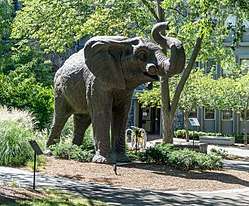Goddard Chapel (Tufts University)
| Goddard Chapel | |
|---|---|
|
Goddard Chapel | |
| General information | |
| Type | Chapel |
| Architectural style | Lombardic Romanesque |
| Town or city | Medford, Massachusetts |
| Country | US |
| Coordinates | 42°24′26″N 71°07′10″W / 42.407092°N 71.119326°WCoordinates: 42°24′26″N 71°07′10″W / 42.407092°N 71.119326°W |
| Named for | Thomas Goddard |
| Renovated | 1959, 2002 |
| Cost | $43,777.33 |
| Owner | Tufts University |
| Technical details | |
| Material | Blue-gray slate |
| Design and construction | |
| Architect | J. Phillip Rinn, Tomasso Juglaris |
| Renovating team | |
| Architect | Arland Dirlam |
Goddard Chapel, built in 1883, is the main religious building at Tufts University in Medford, Massachusetts. The historic chapel was built in the Lombardic Romanesque style. Today the chapel serves as a vibrant center for spiritual and ethical life in the university.
Description
The building was designed by J. Phillip Rinn, who also designed the Barnum Museum of Natural History and part of Metcalf Hall at Tufts. The edifice was designed in the Lombardic Romanesque Style for the chapel's hundred foot bell tower and its cloister, a porch on the east side of the building. The blue-gray slate was quarried locally from Somerville. Originally, Rinn planned the chapel to be covered with ivy to soften the austerity of the stone-work. The interior design also follows Romanesque motifs with the incorporation of the ribbed ceilings, arched woodwork, and stained-glass.The pews, pulpits, and ceiling ribs are made of cherry. The floors are made of oak while the paneling is made of spruce. Today all of the original woodwork is intact. In 2002, the chapel underwent a major restoration. The project returned the chapel ceiling which was painted blue to its native wood.[1] The organ, located on the left side of the chancel was modernized by removing cherry stained wood decorations and panels in front of case pipes. The Andover Organ Company was contracted to rebuild the organ and restore the entire front of the chapel.[2]


Windows
Tomasso Juglaris, an Italian born artist collaborated in the design and creation of the stained-glass windows.[3] Instead of painting on the glass, the colors were etched in, allowing more light to enter the building. The large window behind the pulpit was installed in honor of Goddard and depicts St. Paul wearing brown and blue robes. Opposite the window depicts St. John the Evangelist and was built in memory of Hosea Ballou II. On the west wall there is a stained glass window depicting St. Mark. The three windows on the east side of the chapel also served as memorials. Their designs were inspired by the works of Jean Francois Millet.[4]
History
In the early days of the college, the Coolidge Room on the second floor of Ballou Hall was known as the College Chapel. In 1882, Mary Goddard also known for founding Goddard College contributed $25,000 towards the chapel's construction in honor of her late husband, Tufts trustee Thomas Goddard. At the same time she also donated money for the construction of the Goddard Gymnasium. Additional donations were made by Tufts alumni with the expectation that it would serve as a memorial chapel. In total, construction costs exceeded $40,000. Attendance was mandatory until 1907, when the chapel held service three times a week. The chapel held Protestant services until the Crane School closed in 1969. Portions of the chapel were then converted to house the new Office of the University Chaplain. After the renovation in 2000, the chapel accommodated Catholic mass, Buddhist meditation, Hindu pujas, weddings, memorial services, vigils and concerts in addition to the Protestant services. [5]
References
- ↑ "Goddard Chapel History". Retrieved June 19, 2017.
- ↑ "Goddard Chapel, Tufts University - Boston Organ Studio". Retrieved June 24, 2017.
- ↑ "Boston's Hidden Sacred Places". Retrieved June 24, 2017.
- ↑ Bennett, John; Branco, Jessica; Crowley, Zachary; Sauer, Anne (2000). Concise Encyclopedia of Tufts History.
- ↑ "Looking back at Tufts' religious history". Retrieved June 19, 2017.
